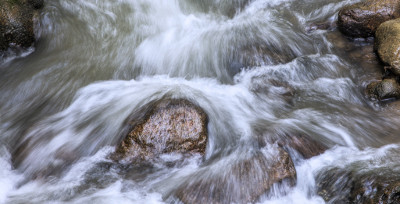
What does it mean to “do but not do,” or “work but not work?” In the image above, when water hits an obstacle, it moves around it with ease instead of pushing to break it. Bamboo responds similarly, by bending when the wind blows, which gives it the capacity to bounce back naturally — a quality of resilience.
In Daoist (or Taoist) tradition*, this is called wu wei — the state of “effortless action,” or “doing without exertion.” It does not mean idleness or apathy; rather, a release of any intentions, resistance, or willful effort. Wu wei, then, is the “do nothing” state.
The state of wu wei also makes our minds and hearts very pure. By aligning ourselves with the laws of the universe rather than resisting or ignoring them, we move with nature’s flow, and life unfolds with seeming grace. We harmonize with everything and everyone around us, bringing benefit to ourselves and the world through spontaneous action. Wu wei, then, is the “do everything” state.
Do nothing, but do everything? (Yes.)
To the reference framework (or thinking mind), this can be confusing. But from the perspective of Mingjue — the inner observer, pure consciousness — we see that being and doing are one. That is, what we do emerges as a natural expression of our coherent state of being.
In Mingjue gongfu practice, we train to first come to the Mingjue entirety state, where
consciousness merges with the collective consciousness field and with our qi (energy) bodies. In this expansive state, we let go of our own personal intentions, agendas, or ideas; we let go of all attachments. As a result, our hearts become liberated, and our bodies more spacious and relaxed. This is a beautiful life state.
Wu wei flows with the eternal balancing of forces: yin and yang. These polarities are not opposites that negate or repel each other; they are complementary partners that bring balance to the universe, like masculinity and femininity, light and darkness, heaven and earth, filling and emptying. Both are necessary for the whole. Both are vital for optimal health. And both are in constant flow, riding the cycles of evolutionary change.
From this free state of being, we experience ourselves as Mingjue (or universal) love. Compassion and kindness naturally arise, which can minimize harmful interference with nature and human affairs. Wu wei can help unleash us from self-consciousness, self-judgment, and fear.
What does wu wei have to do with healing? Wu wei can potentiate healing. It is the natural healing state.
Have you experienced this state? How long can you stay in it? If wu wei feels elusive — because it is indeed a practice, a gongfu (training) — you can start by observing the mental, emotional, or physical resistances within yourself as you move through your days, and practice relaxing them.
*Zhineng Qigong is based on different philosophies, scientific theory, philosophy, folk qigong, and the wisdom traditions of Daoism, Buddhism, and Confucianism.
Adapted and expanded from the course,“Awakening the Inner Healer,” Module 2, Part 1 (September 2022), as taught by Teacher Wei.
__________
DEEPENING YOUR PRACTICE
We offer creative materials to help deepen your observations, connect better to the practice, or to understand the theories. Review them as you feel inspired. Keep whatever supports your process; disregard if not useful. There will come a time when you go beyond all images and tools in your practice.
The state of wu wei is not just a mental concept — it is a state that infuses the mind, spirit, and body.
Play this exquisite 6-min video of Daoist priests who have lived on the sacred Wudang Mountain of China since childhood, as they practice tai chi and Wudang kung fu, accompanied by a Daoist song. Watch their movements, feel the melodic vibrations, and merge with the good information of their wu wei existence.
P.S. If you listen carefully to the opening set of lyrics, you will hear “tian ren he yi” (we and heaven are one) in there.
__________
PRACTICE LOWER DANTIAN BREATHING
Find a few times during your day to do this for 10-15 minutes. If helpful, set an alarm on your phone during breaks in the day.
First, set a good mingjue entirety state (6-min video).
Draw your mind into shenji palace (center of your head).
Relax. Feel an inner silence.
Observe the breath, slow and gentle.
With each inhalation, feel qi filling up the lower dantian (in the center of your abdomen). With each exhalation, the body relaxes, lower dantian contracts.
When you feel the qi in lower dantian is strong enough, begin observing with each inhalation the qi merging into the middle dantian (in the center of your chest), then the upper dantian (in the center of your head).
As you exhale, relax.
You may also hold your breath for a short while. Relax as much as possible as you hold your breath. This is also a good way to integrate and harmonize internal qi and make it stronger.
Always hold the question: Who is breathing into lower dantian?
In daily life: throughout your day, you can always practice lower dantian breathing. It does not require any hand or body movements. If you feel triggered by something or someone, begin this practice. If you feel tired, begin this practice. See how quickly you can come back to yourself, your center.
Lower dantian breathing — and observing the lower dantian breathing — is a powerful foundation to the wu wei state.
__________
REFLECTIONS FROM THE COMMUNITY
During this module, we focused on standing meditation, lower dantian breathing, and throat breathing.
One person shared…
“During the evening, I continued with my standing meditation, hard breathing, middle dantian practice, lower dantian, and shenji palace practice. I have noticed that noise does not bother me as much as it used to before, and that I am able to turn the noise off, and tune inside to observe my inner self. It’s such a sense of relaxation. I am walking slower, I am taking my time when I talk, and also I am not responding to others’ inquiries in a rushed manner.”
Another person shared…
“I am particularly thrilled to rediscover standing meditation [or 3-centers merge]. When I first learned standing meditation several years ago, it was to squat in an uncomfortable position and hang out waiting for something good to happen. Now I see it as a wonderful way to interact with the universe. To actively engage hunhua [merging and transforming] with the material, energetic, and informational levels, as well as the movement of universal qi.”
__________
STUDY AND PRACTICE MINGJUE GONGFU WITH US
- Practice with a vibrant, global community in our yearlong program, “Awakening the Inner Healer,” which started in June 2022. It’s never too late to join! Monthly courses are available a la carte, and translations are available in multiple languages.
- “What is the World Consciousness Community?” in Teacher Wei’s words (3-min video)
